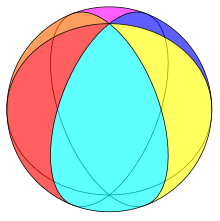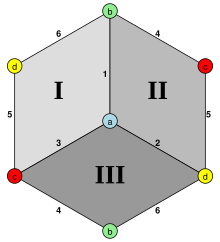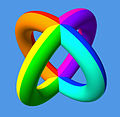Regular map (graph theory)


In
Overview
Regular maps are typically defined and studied in three ways: topologically, group-theoretically, and graph-theoretically.
Topological approach
Topologically, a map is a 2-cell decomposition of a compact connected 2-manifold.[1]
The genus g, of a map M is given by Euler's relation which is equal to if the map is orientable, and if the map is non-orientable. It is a crucial fact that there is a finite (non-zero) number of regular maps for every orientable genus except the torus.
Group-theoretical approach
Group-theoretically, the permutation representation of a regular map M is a transitive permutation group C, on a set of flags, generated by three fixed-point free involutions r0, r1, r2 satisfying (r0r2)2= I. In this definition the faces are the orbits of F = <r0, r1>, edges are the orbits of E = <r0, r2>, and vertices are the orbits of V = <r1, r2>. More abstractly, the automorphism group of any regular map is the non-degenerate, homomorphic image of a <2,m,n>-triangle group.
Graph-theoretical approach
Graph-theoretically, a map is a cubic graph with edges coloured blue, yellow, red such that: is connected, every vertex is incident to one edge of each colour, and cycles of edges not coloured yellow have length 4. Note that is the flag graph or graph-encoded map (GEM) of the map, defined on the vertex set of flags and is not the skeleton G = (V,E) of the map. In general, || = 4|E|.
A map M is regular if Aut(M)
Examples

- The great dodecahedron is a regular map with pentagonal faces in the orientable surface of genus 4.
- The hemicube is a regular map of type {4,3} in the projective plane.
- The hemi-dodecahedron is a regular map produced by pentagonal embedding of the Petersen graph in the projective plane.
- The p-hosohedron is a regular map of type {2,p}.
- The Dyck map is a regular map of 12 octagons on a genus-3 surface. Its underlying graph, the Dyck graph, can also form a regular map of 16 hexagons in a torus.
The following is a complete list of regular maps in surfaces of positive Euler characteristic, χ: the sphere and the projective plane.[2]
| χ | g | Schläfli | Vert. | Edges | Faces | Group | Order |
Graph | Notes | |
|---|---|---|---|---|---|---|---|---|---|---|
| 2 | 0 | {p,2} | p | p | 2 | C2 × Dihp | 4p | Cp | Dihedron | |
| 2 | 0 | {2,p} | 2 | p | p | C2 × Dihp | 4p | p-fold K2 | Hosohedron | |
| 2 | 0 | {3,3} | 4 | 6 | 4 | S4 | 24 | K4 | Tetrahedron | |
| 2 | 0 | {4,3} | 8 | 12 | 6 | C2 × S4 | 48 | K4 × K2 | Cube | |
| 2 | 0 | {3,4} | 6 | 12 | 8 | C2 × S4 | 48 | K2,2,2 | Octahedron | |
| 2 | 0 | {5,3} | 20 | 30 | 12 | C2 × A5 | 120 | Dodecahedron | ||
| 2 | 0 | {3,5} | 12 | 30 | 20 | C2 × A5 | 120 | K6 × K2 | Icosahedron | |
| 1 | n1 | {2p,2}/2 | p | p | 1 | Dih2p | 4p | Cp | Hemi-dihedron[3] | |
| 1 | n1 | {2,2p}/2 | 2 | p | p | Dih2p | 4p | p-fold K2 | Hemi-hosohedron[3] | |
| 1 | n1 | {4,3}/2 | 4 | 6 | 3 | S4 | 24 | K4 | Hemicube | |
| 1 | n1 | {3,4}/2 | 3 | 6 | 4 | S4 | 24 | 2-fold K3 | Hemioctahedron
| |
| 1 | n1 | {5,3}/2 | 10 | 15 | 6 | A5 | 60 | Petersen graph | Hemidodecahedron
| |
| 1 | n1 | {3,5}/2 | 6 | 15 | 10 | A5 | 60 | K6 | Hemi-icosahedron | |
The images below show three of the 20 regular maps in the
-
{6,4}
-
{4,8}
-
{8,4}
Toroidal polyhedra
Regular maps exist as torohedral polyhedra as finite portions of Euclidean tilings, wrapped onto the surface of a
Regular maps of the form {4,4}m,0 can be represented as the finite regular skew polyhedron {4,4 | m}, seen as the square faces of a m×m duoprism in 4-dimensions.
Here's an example {4,4}8,0 mapped from a plane as a chessboard to a cylinder section to a torus. The projection from a cylinder to a torus distorts the geometry in 3 dimensions, but can be done without distortion in 4-dimensions.
| χ | g | Schläfli | Vert. | Edges | Faces | Group | Order |
Notes |
|---|---|---|---|---|---|---|---|---|
| 0 | 1 | {4,4}b,0 n=b2 |
n | 2n | n | [4,4](b,0) | 8n | Flat toroidal polyhedra Same as {4,4 | b} |
| 0 | 1 | {4,4}b,b n=2b2 |
n | 2n | n | [4,4](b,b) | 8n | Flat toroidal polyhedra Same as rectified {4,4 | b} |
| 0 | 1 | {4,4}b,c n=b2+c2 |
n | 2n | n | [4,4]+ (b,c) |
4n | Flat chiral toroidal polyhedra |
| 0 | 1 | {3,6}b,0 t=b2 |
t | 3t | 2t | [3,6](b,0) | 12t | Flat toroidal polyhedra |
| 0 | 1 | {3,6}b,b t=3b2 |
t | 3t | 2t | [3,6](b,b) | 12t | Flat toroidal polyhedra |
| 0 | 1 | {3,6}b,c t=b2+bc+c2 |
t | 3t | 2t | [3,6]+ (b,c) |
6t | Flat chiral toroidal polyhedra |
| 0 | 1 | {6,3}b,0 t=b2 |
2t | 3t | t | [3,6](b,0) | 12t | Flat toroidal polyhedra |
| 0 | 1 | {6,3}b,b t=3b2 |
2t | 3t | t | [3,6](b,b) | 12t | Flat toroidal polyhedra |
| 0 | 1 | {6,3}b,c t=b2+bc+c2 |
2t | 3t | t | [3,6]+ (b,c) |
6t | Flat chiral toroidal polyhedra |
In generally regular toroidal polyhedra {p,q}b,c can be defined if either p or q are even, although only euclidean ones above can exist as toroidal polyhedra in 4-dimensions. In {2p,q}, the paths (b,c) can be defined as stepping face-edge-face in straight lines, while the dual {p,2q} forms will see the paths (b,c) as stepping vertex-edge-vertex in straight lines.
Hyperbolic regular maps
See also
- Topological graph theory
- Abstract polytope
- Planar graph
- Toroidal graph
- Graph embedding
- Regular tiling
- Platonic solid
- Platonic graph
References
- ^ Nedela (2007)
- ^ Coxeter & Moser (1980)
- ^ a b Séquin (2013)
- Coxeter1980, 8.3 Maps of type {4,4} on a torus.
- Coxeter1980, 8.4 Maps of type {3,6} or {6,3} on a torus.
- Coxeterand Moser, Generators and Relations for Discrete Groups, 1957, Chapter 8, Regular maps, 8.3 Maps of type {4,4} on a torus, 8.4 Maps of type {3,6} or {6,3} on a torus
- ^ https://web.archive.org/web/20181126084335/https://sites.math.washington.edu/~grunbaum/Your%20polyhedra-my%20polyhedra.pdf
Bibliography
- ISBN 978-0-387-09212-6.
- doi:10.1145/1531326.1531355, archived from the original(PDF) on 2011-06-09.
- .
- Nedela, Roman (2007), Maps, Hypermaps, and Related Topics (PDF).
- Vince, Andrew (2004), "Maps", Handbook of Graph Theory.
- Brehm, Ulrich; Schulte, Egon (2004), "Polyhedral Maps", Handbook of Discrete and Computational Geometry.
- Séquin, Carlo (2013), "Symmetrical immersions of low-genus non-orientable regular maps" (PDF), Berkeley University.


























